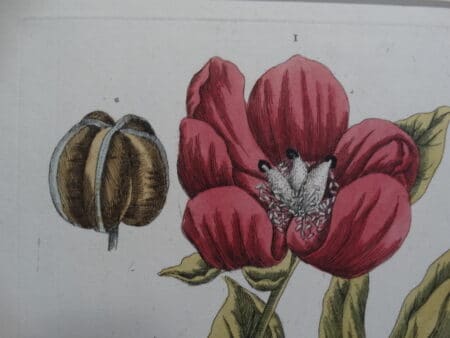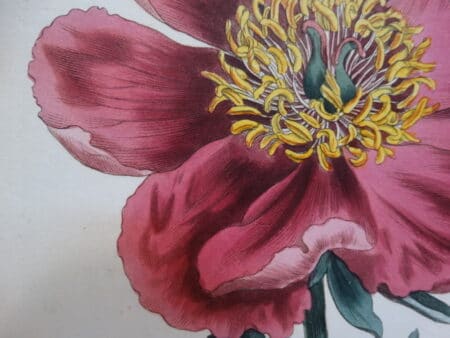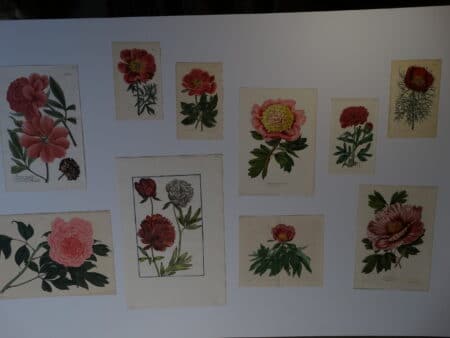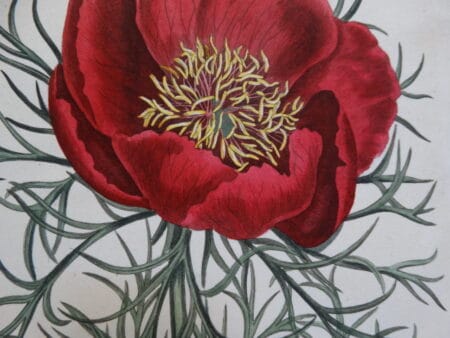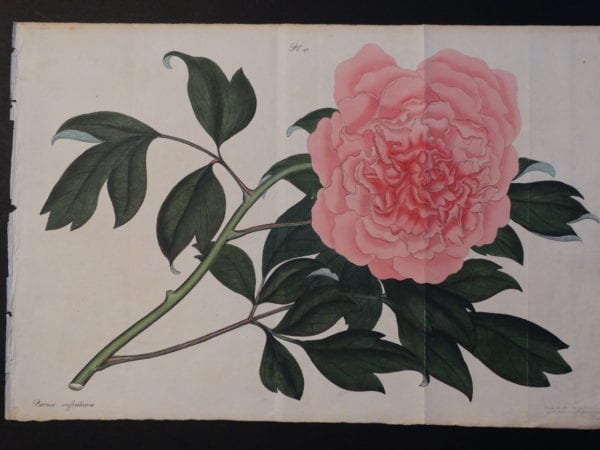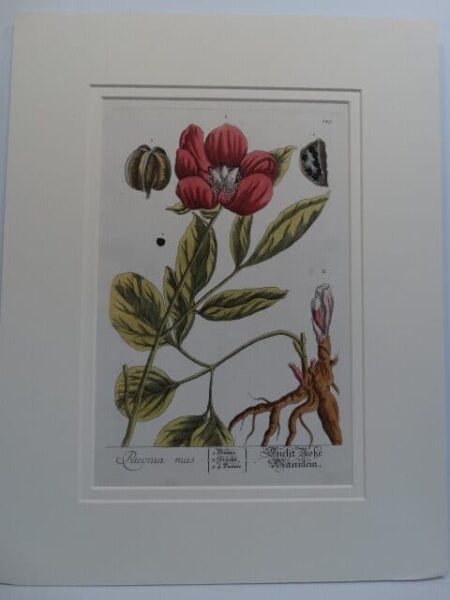Paeonies: Antique lithographs and watercolor engravings. Our Peony or Paeonia prints, are remarkable paper antiques, that are over 100 years old. Let us help you with your decorating project.
18th & 19th Century, Antique Prints Engravings Lithographs, of Paeonia or Peonies
Paeony Bloom | 200 year old engraving | by Henry C. Andrews
Wonderful large antique peony engraving by Henry C. Andrews. This English hand-colored (copper plate) engraving is on (hand-made) rag paper. Extremely accomplished, he was the illustrator, engraver, colorist and publisher, for his works. Published 200 years ago, the 1805. The engraving is sourced from Henry Andrew’s book on roses. It is entitled: A Monograph on the Genus Rosa, containing colored figures of all the Known Species. And Beautiful Varieties. 1805. This special fold out engraving, measures 11×17″. $600.
Johann Wilhelm Weinmann, Antique Engraving of Peony, from Phytanthoza Iconographia
German hand colored copper plate engravings by Johann Wilhelm Weinmann for Phytanthoza Iconographia, which was published from 1737-1745. Beautiful condition. Measuring in at 9 1/2 x 14”.
Pierre Joseph Redoute, Paeonia, Stipple Plate Engraving
Pierre Joseph Redoute Paeonies Plate 103 published 1827-1833 in Paris France. Small folio hand water colored stipple plate engraving in excellent condition. 10×12″ $1200.
Antique Peony Engraving, from Curious Herbal, by Elizabeth Blackwell, c.1750
A leaf or bookplate from a medical handbook entitled Curious Herbal by Elizabeth Blackwell. Mid 18th century antique peony engraving with watercolors. Matted in double rag museum quality matting measuring 14×18″. Mint condition. $650.
Daniel Rabel, and Maria Sybilla Merian: Histoire Generalle des Insectes de Surinam et de toute l’Europe
Daniel Rabel and Maria Sybilla Merian Peonies sourced from Histoire Generalle des Insectes de Surinam et de toute l’Europe, Paris 1771. 13×19″ This 18th century watercolor (copperplate) engraving is in excellent condition. $950. Call 413-245-4197 to place your order.
Peony Engravings Dating 1613-1713 Basilus Besler’s Hortus Eystettensis
1613-1713 Basilus Besler’s Hortus Eystettensis sive Diligens et accurata omnium Plantarum Florum Stirpium. All three additions of Hortus Eystettensis published in Eichstatt and Nuremberg Germany between 1613 and 1713. The work was to illustrate the magnificent fancy flowers in the Bishops Garden. This garden is where the bishop could go to be closer to heaven. Here he could praise God and celebrate the diversity of God’s creation.
In 1613 Basil Besler published the first edition of Hortus Eystettensis. It was the first important botanical work ever done on fancy flowers. It was printed in black-and-white, from copper plate engraving. There is text on the other side. Approximately 300 printed. 25 of those had watercolors added at the time, of the turn of the 17th century, up to 1613.
The second edition of Basil Besler’s Hortus Eystettensis was published in 1640 in Eichstatt and had a serpent watermark in the paper. Most have no printing on the verso while there was a few that did. The second edition was only fulfilled in black and white.
In 1713 Basil Besler’s work was published for the third time. Basilus Besler’s Hortus Eystettensis sive Diligens et accurata omnium Plantarum Florum Stirpium. Published in Nuremberg and Eichstatt, Germany. There is printing on the verso, and the paper is thicker. Paper making had evolved in the previous century. This edition was published in black and white. Meaning the water colors have been added sometime since to pieces you see in color.
Antique Peony Engravings from the Botanical Magazine & Botanical Register
William Curtis established, authored and published an early English periodical named Botanical Magazine in February 1787. He created demand and ran the magazine until 1800. His leadership was followed by foe John Simms 1800-1826, William Jackson Hooker 1827-1865, and Joseph Dalton Hooker from 1865 to 1904. Many artists worked on the publication. They were Sydenham Edwards, William Graves, James Sowerby, John Curtis, William Jackson Hooker, W.H. Fitch, Matilda Smith, Lillian Snelling and Stella Rose Craig. Botanical Magazine was very popular. The watercolors, which were applied to the copper plate engravings, brought the magazine to life. Lots of subscriptions were sold as it was affordable. Subscribers collected issues. Which were generally catalogued chronologically and bound by the year. The gardening Botanical Magazine ran nearly 160 years.

Curtis Edwards Peony Plate 1422 published by T. Curtis St. Geo Crescent Sept 1, 1807 5 1/2 x 9″ $300. 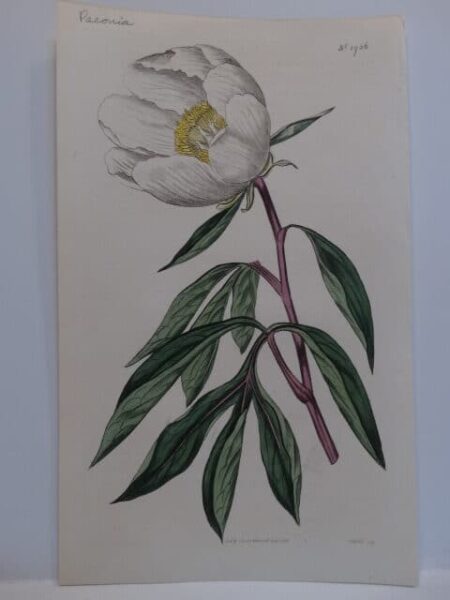
Curtis Peony Engraving No.1756. 5 1/4 x 9″ $175. 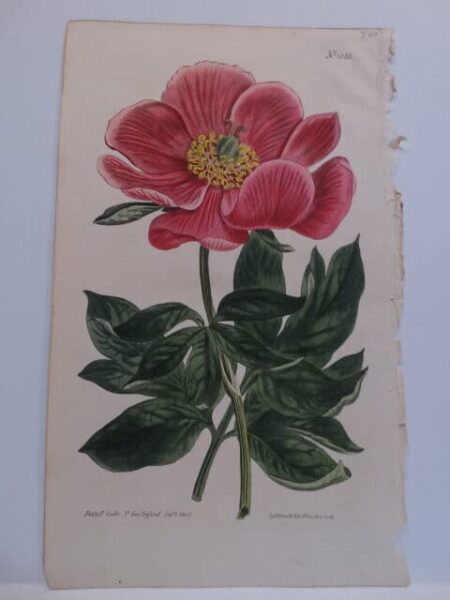
Curtis Edwards Peony No.1050. Mint condition and color. 5 1/2 x 9″ $300. 
Antique Peony Engraving, Edwards926 $300. 
Sweet Paeony,
Paradoxa Plate19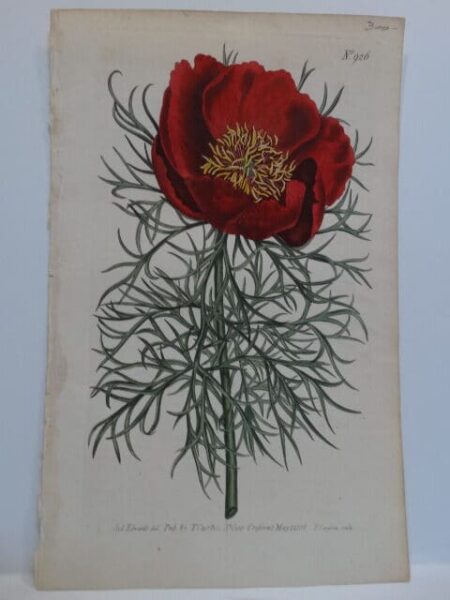
Peony No.926 $250. see left edge.
The artist and illustrator responsible for most of the plates in Botanical Magazine was Sydenham Edwards. English, he lived 1768-1819. He was the first full time artist to work for the magazine. William Curtis had seen Edwards artwork and sought to hire him. Soon Edwards the apprentice and William Curtis became an inseparable friends. They took many expeditions and created the beautiful artwork you are seeing here today. Edwards was the only artist until 1815. After about 13 years of building the establishment, Curtis left Botanical Magazine. He and James Ridgeway, set up a new magazine called The Botanical Register. Which was less prolific and most likely more expensive to subscribe. The work is even more detailed and has more intense watercolors.
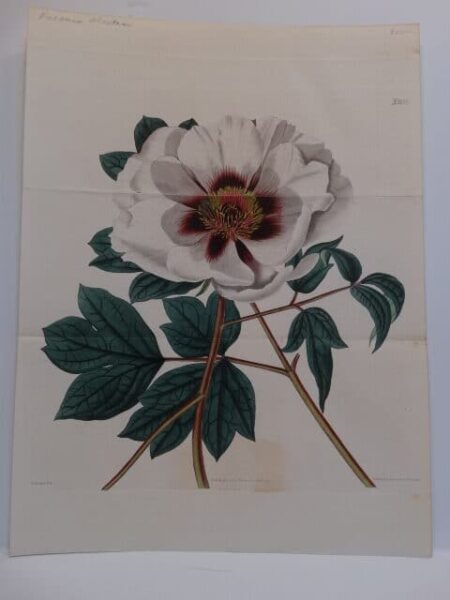
Curtis Paeonia Mountain N2175. 9 x 11 3/4″. Light staining lower middle with issue folds. $95. 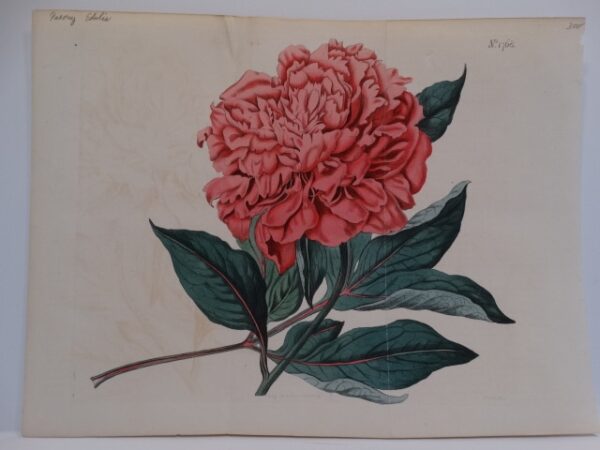
Curtis No.1768 Paeony Edulis 9×12″ Standard issue fold with light offsetting on left side. $150. 
Sweet Paeonia Mollis Plate474. Bright watercolors, copper plate engraving. 9 1/2 x 10 3/4″ with one issue fold. $175. 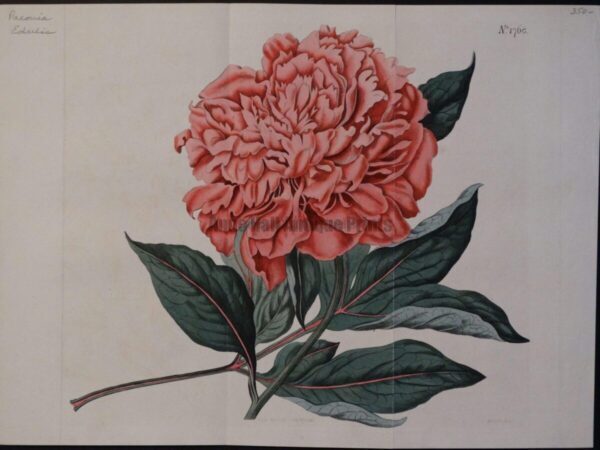
Curtis Pink Paeony English hand colored engraving, c. 1820 fold out 9×14″ $325 
Curtis Chinese Tree Paeony, Double page fold out. English Antique. The hand colored engraving is approximately 210 years old. Published 1808. 9×14″ $325
Assorted Paeonies: Antique Lithographs from the Mid-19th Century
From mid 19th Century hand finished antique lithographs to 18th Century. Browse my unique selection of old peony prints which came from assorted subscriptions, catalogs and horticultural books from years ago.

Stroobant White Mountain Peony
10×13″ $175.
Van Houtteano Foxed Pink Peony Belgian Lithograph 1845-88. 4 folds as issued. Please inspect. 9 3/4 x 13 13 1/4″. $100. 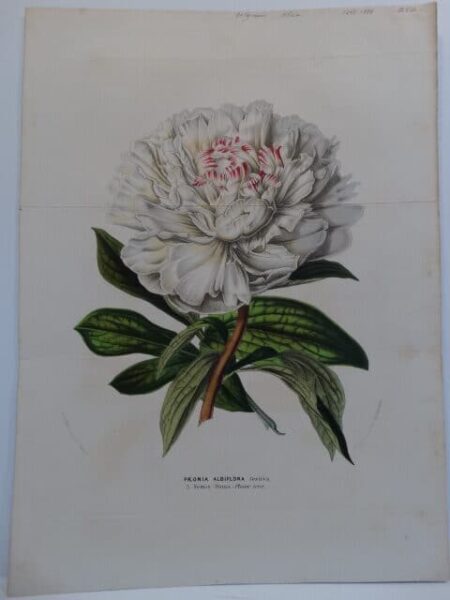
Peonia Albiflora Van Houtteano
9 3/4 x 13 13 1/4″ $100.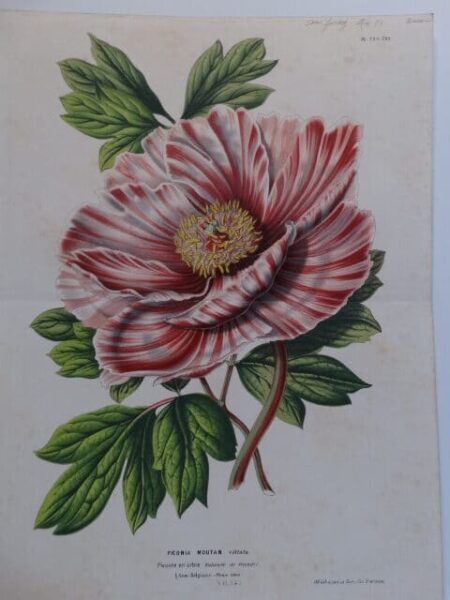
Paeonia Moutan vittata VanHoutte
9 3/4 x 13 13 1/4″ $150.
Paeonia Moutan Triomphe Gand
9 3/4 x 13 13 1/4″ $150.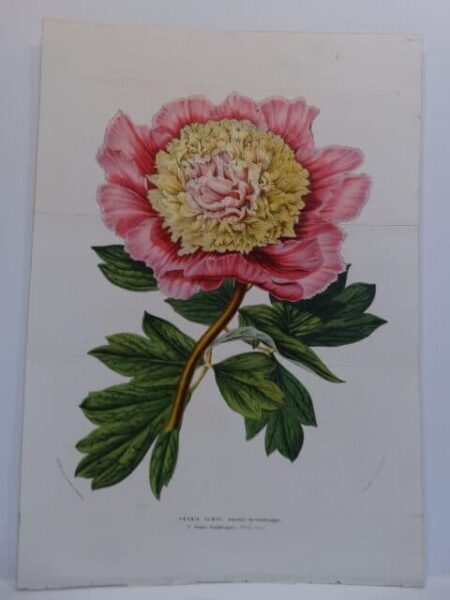
Paeonia Albifl Souvenir
Gendbrugge 10×13″. $200.
Lithography, centuries ago, briefly explained:
The art of lithography was a very laborious process. It took tremendous skill. It was a life long craft, once a lithographer, always a lithographer! No switching back and forth in careers in the OLD days. One would serve a long apprenticeship, sometimes years on end, with little to no pay, in order to become a craftsman like the one skilled to work on these rare hand colored lithographs of bouquets produced. The desired, original illustration was transferred onto a special kind of limestone. The limestone came out of a certain area of Germany. The limestone was cut into large slabs, about 1″ thick. The illustration was meticulously drawn onto the limestone slab with a type of a greasy crayon. What was under the greasy crayon essentially was what was printed in relief. The finished desired slab was then emerged into nitric acid. The nitric acid burned away what was not covered by the greasy crayon. That area was then in relief. The greasy crayon was wiped off, inked up, and printed onto a piece of heavy wove rag paper. (The making of the paper is another story).
The water-coloring was meticulously added by a very experienced water-colorist. Water coloring was also a life long career or craft. Intense ink from minerals and vegetables and insects made up water colors in the early days. These water colored lithographs are vibrant and beautiful. The prints themselves are in near perfect condition. The bouquets are stunning to look at in person
Thank you for visiting! Call Anne at 413-245-4197 to talk about your project or to place your order.

